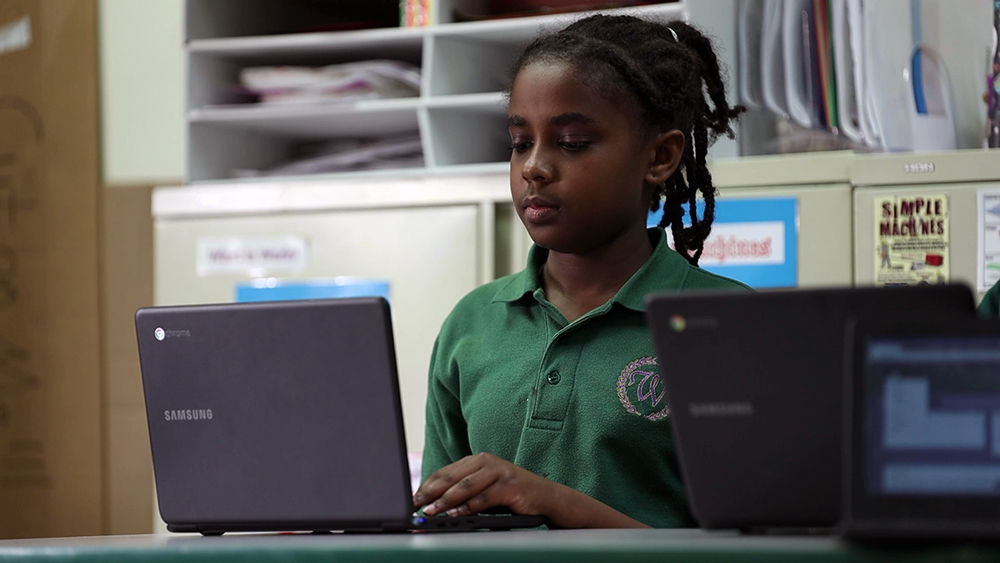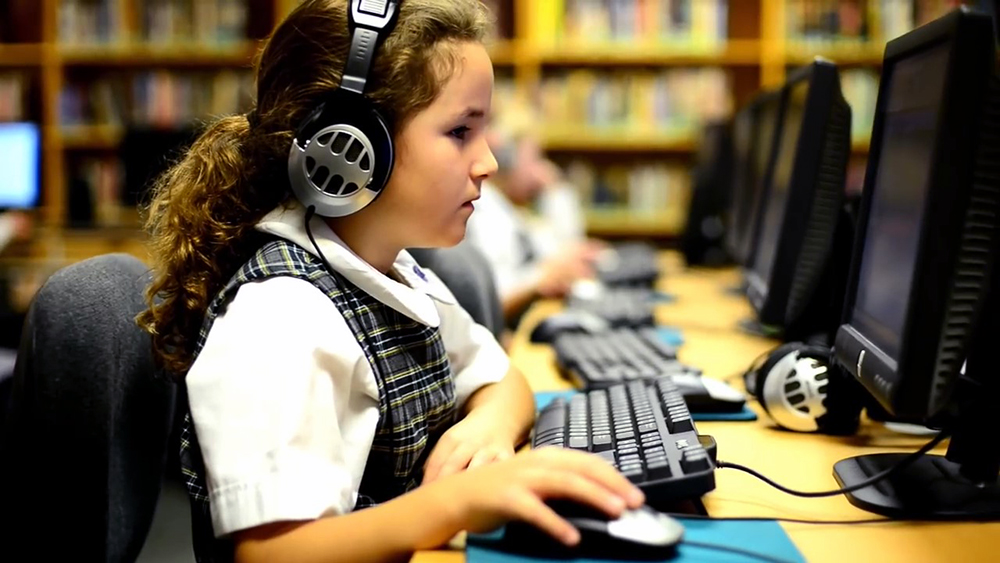
How do we find the right balance in today’s modern world, where technology and education increasingly intersect? At Westminster, we navigate this intersection with a unique approach, blending technology with classical education to provide a holistic learning experience. Through the lens of a classical private school, we deeply value the arts, actual books, and the value of human connections. However, the impact of technology is prevalent and would be foolhardy to ignore. Because of this, parents and educators must consider and leverage the benefits of technology in education.
First, technology can enable new opportunities for students to collaborate, communicate, and access opportunities that strengthen their education.
Classrooms today look much different from the past. Smartboards, laptops, and interactive learning systems play a larger role in students’ education than ever before. Teachers and parents interact in online portals, having the ability to send grades and messages about students’ progress.
Technology unlocks countless opportunities for teachers and students.
“Access to learning opportunities today is unprecedented in scope thanks to technology,” research at Purdue University shows. “Traditionally, classrooms have been relatively isolated, and collaboration has been limited to other students in the same classroom or building. Today, technology enables forms of communication and collaboration undreamt of in the past.”
The Synergy of Classical Arts and Modern Technology
Westminster School holds a unique position in the Northern Virginia educational landscape. With this stance, Westminster leverages technology as a complementary tool to our classical curriculum, ensuring our students benefit from both worlds.
Here, technology is used where appropriate to enhance, not replace, traditional teaching methods. Technology is a tool to be used alongside learning, not a complete solution. This dual focus ensures that our students receive a well-rounded education, steeped in both time-honored knowledge and contemporary skills.
Technology in Education
Technology in education can mean anything from interactive simulations to online grading systems. The use of technology in education can include coding and programming classes, digital literacy, privacy protection, student collaborative learning opportunities, and STEAM programs. Technology can be used in whole-class instruction, individual work, and small-group work. Understanding how important technology is in education, Westminster incorporates it thoughtfully. Thus ensuring it enriches, rather than distracting from, the learning process.
Other examples of technology in education:
- Google Classroom
- Interactive whiteboard
- 3D printing
- Robotics
- Coding and Programming
- Learning management and grading systems
- Online tutoring systems
While the impact of technology can be beneficial, there are still challenges.
Benefits of technology in education include:
- Increased engagement, especially for auditory or visual learners,
- Incorporating different learning styles and interests,
- Collaborative learning opportunities,
- Reducing costs and use of materials, and
- Assisting teachers.
Challenges of technology in education include:
- Hindering social skills,
- Affecting time management,
- Impacting health, specifically vision or concentration,
- Privacy concerns, and
- Exposure to inappropriate content.
At Westminster, we proactively address these challenges. By integrating digital literacy and internet safety into our curriculum, we foster responsible and informed technology use.
The Benefits of Technology in Education
Technology in education ignites students’ curiosity and personalizes their learning experience. Using technology, we have new tools to teach students to collaborate and think critically. With the help of technology, teachers can better include and communicate with parents.
Research shows that through engaging content, teachers spark “inquisitiveness in children and boost their curiosity.” By igniting curiosity, students achieve greater academic success. Technology enables a more personalized understanding of difficult concepts for students, including subjects like science and math.
Technology in education can help educators by increasing a teacher’s efficiency and productivity. This allows teachers more time to instruct and engage with students.
STEAM Program at Westminster School
Here at Westminster School, technology is appropriately integrated across grade levels. Students and teachers understand its role in enhancing traditional teaching methods and enriching student learning. Some of the technology we leverage includes interactive whiteboards, iPads in the middle and upper grades, and various educational software and applications.
Our focus is on responsible use of technology, teaching students about digital citizenship and internet safety. This integration reflects Westminster’s commitment to preparing students for the digital age while maintaining the core classical education principles.
Students in grades 3-8 at Westminster have the opportunity to take STEAM (Science, Technology, Engineering, Arts, and Mathematics) and technology enrichment classes. The STEAM program goes beyond students merely using a computer. Students learn computer safety, word processing, the history of technology, Computer-Aided Design (CAD), programming and coding, electronics, robotics, and design.
Our STEAM program is a testament to how we blend technology with classical education, providing hands-on experiences to foster technical proficiency and critical thinking.
How Westminster’s Use of Technology Differs From Other Schools

The integration of education and technology is a delicate balance. However, Westminster School understands the role of STEAM in learning and equipping students for the modern world. Westminster blends these curricular goals without compromising its core values, like respect, kindness, integrity, and responsibility.
Westminster School gives students the tools they need to access technology and succeed in the realms of higher education and the professional world. It provides students with lifelong learning opportunities. Its mission is to give students a consistent and carefully planned education, cultivating intellectual, social, and emotional development.
By striking this balance, Westminster School stands as a model of how technology in education can be harnessed to enrich classical education as well as prepare students for the present and future.
Does this sound like the education that you want for your child?
Schedule a tour to see the Westminster campus. Learn more about how it balances the impact of technology in education alongside its core values today.


Thanks for sharing. I read many of your blog posts, cool, your blog is very good.